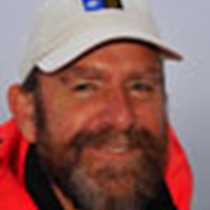Saginaw Bay and Halleck Harbour, Kuiu Island
After a beautiful streaked sunset, a pearly half moon and a starry, starry night, we wake to an apricot dawn that soon dissolves into the familiar Alaskan mists. We slid quietly into Saginaw Bay at low tide, the peace broken only by squabbling Bonaparte’s gulls. Harbour seals are sprawled on seaweed sofas, Bald Eagles sit nonchalantly on the gravel beaches ogling the passing salmon, and at the end of the creek we spot a black bear going for an early morning jog. As he halts, a second bear joins him, possibly a sibling. In a second inlet is a third bear; a fourth strolls along an outer beach, checking the strand line for tidal tidbits before clambering back into the forest. The salmon season is every teddy bear’s favourite picnic.
Sea Lion anchors in Halleck Harbour, and within 20minutes we have kayaks down to explore this quiet lagoon. Some paddle west, passing rafts of jet black scoters. Others paddle east and on the limestone bluffs of the outer shore they stumble upon this extraordinary pictograph: a wide-eyed face in a sun circle, painted on the cliff in indelible red ochre. For thousands of years these wooded islands were home to the Tlingit Indians; this bold design reminds us that we are travelling in their footsteps. The wild black currants still grow on their shore, the sheets of cranberry and juniper still clothe their cliffs and the same peace still pervades the sheltered bay. But now it is home only to the bear and the otter: we find bear claw marks and fresh otter scat on a fallen trunk on the beach. As we gaze up at the cliffs, geologist Scott Babcock points out the presence of hundreds of ancient seashells laid down in a tropical sea thousands of miles away and millions of years ago. What a strange journey Time is.
There is plenty of time for us to ponder this paradox as we steam west for Sitka. But there are more wonders still: we come upon a dozen humpback whales lunge-feeding at the surface, mouths agape they scoop tons of water up to sieve out the tiny plankton. Each time they sink, a flock of hungry phalaropes, tiny migrating shorebirds, alight on their swirling footprints to gorge on the plume of copepods brought to the surface. And as we leave the gorging giants and their tiny tablemates, we find we have an escort of orcas travelling the same route. This is Alaska: where else can one dine with giants and cruise with killers? Both body and soul have been wonderfully nourished this week, the former by Dungeness crab, fresh halibut and local King Salmon, the latter by ancient forests, magical mists and frolicking leviathans at sea. Now we understand why Alaska tugs so powerfully at the heartstrings, and why those who know this wild landscape have that faraway look in their eyes when they extol its wonders.
After a beautiful streaked sunset, a pearly half moon and a starry, starry night, we wake to an apricot dawn that soon dissolves into the familiar Alaskan mists. We slid quietly into Saginaw Bay at low tide, the peace broken only by squabbling Bonaparte’s gulls. Harbour seals are sprawled on seaweed sofas, Bald Eagles sit nonchalantly on the gravel beaches ogling the passing salmon, and at the end of the creek we spot a black bear going for an early morning jog. As he halts, a second bear joins him, possibly a sibling. In a second inlet is a third bear; a fourth strolls along an outer beach, checking the strand line for tidal tidbits before clambering back into the forest. The salmon season is every teddy bear’s favourite picnic.
Sea Lion anchors in Halleck Harbour, and within 20minutes we have kayaks down to explore this quiet lagoon. Some paddle west, passing rafts of jet black scoters. Others paddle east and on the limestone bluffs of the outer shore they stumble upon this extraordinary pictograph: a wide-eyed face in a sun circle, painted on the cliff in indelible red ochre. For thousands of years these wooded islands were home to the Tlingit Indians; this bold design reminds us that we are travelling in their footsteps. The wild black currants still grow on their shore, the sheets of cranberry and juniper still clothe their cliffs and the same peace still pervades the sheltered bay. But now it is home only to the bear and the otter: we find bear claw marks and fresh otter scat on a fallen trunk on the beach. As we gaze up at the cliffs, geologist Scott Babcock points out the presence of hundreds of ancient seashells laid down in a tropical sea thousands of miles away and millions of years ago. What a strange journey Time is.
There is plenty of time for us to ponder this paradox as we steam west for Sitka. But there are more wonders still: we come upon a dozen humpback whales lunge-feeding at the surface, mouths agape they scoop tons of water up to sieve out the tiny plankton. Each time they sink, a flock of hungry phalaropes, tiny migrating shorebirds, alight on their swirling footprints to gorge on the plume of copepods brought to the surface. And as we leave the gorging giants and their tiny tablemates, we find we have an escort of orcas travelling the same route. This is Alaska: where else can one dine with giants and cruise with killers? Both body and soul have been wonderfully nourished this week, the former by Dungeness crab, fresh halibut and local King Salmon, the latter by ancient forests, magical mists and frolicking leviathans at sea. Now we understand why Alaska tugs so powerfully at the heartstrings, and why those who know this wild landscape have that faraway look in their eyes when they extol its wonders.




